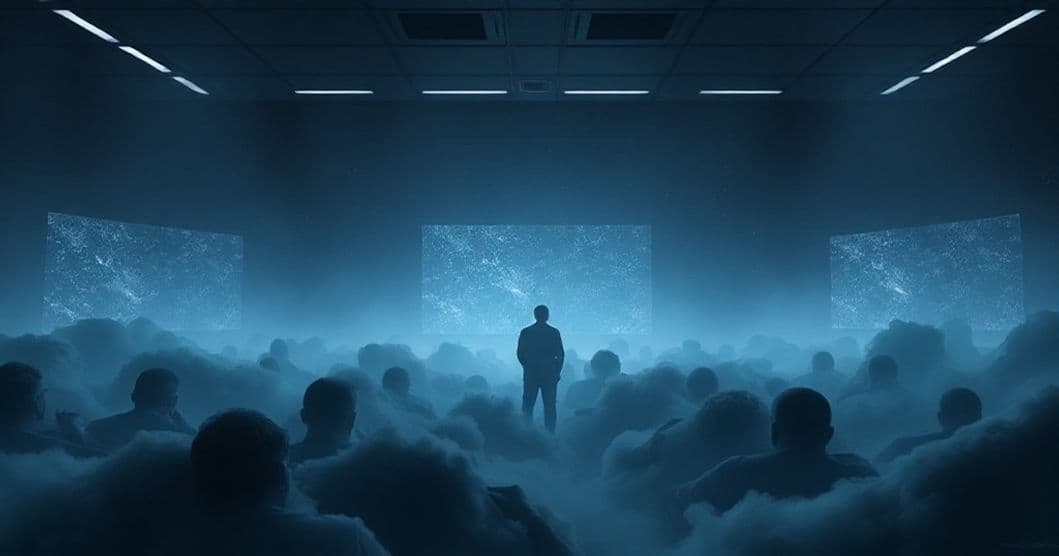Black Screens, Awake Dreams: Interpreting a Premonition of Disruption
Part 1: Dream Presentation
Dreams often serve as bridges between our conscious awareness and the deeper currents of our psyche, sometimes mirroring waking events with uncanny precision. This particular dream, with its eerie prescience, offers a fascinating window into how the unconscious processes technological disruption and psychological boundaries. Here is the dream narrative as the dreamer experienced it:
Several weeks ago, I found myself standing in our living room—a space so vividly familiar it might have been a waking moment. The room’s layout, the texture of the couch, even the faint scent of citrus from the candle on the coffee table were indistinguishable from reality. Yet something felt profoundly off: every surface that should have held screens—TVs, laptops, computers, even the small tablet on the side table—was replaced by black, silent displays. They flickered not with light, but with the absence of it, as if the devices themselves had been drained of purpose. I wandered through the room, touching the cool edges of these lifeless screens, a strange sense of unease settling over me.
Fast forward to now: our television, which had been sputtering and failing for weeks, finally died completely just a few nights ago. In the intervening days, we’ve scrambled to replace it, filling our living room with every available screen we own—a broken flat-screen we’re trying to repair, another that won’t turn on, my laptop, and my boyfriend’s computer monitor. The space now resembles a technological graveyard, just as my dream had depicted it. I’d half-expected this disruption, a vague sense that our reliance on screens was reaching a breaking point, but the dream’s precision still startled me.
Want a More Personalized Interpretation?
Get your own AI-powered dream analysis tailored specifically to your dream
🔮Try Dream Analysis FreeAs I stood in this surreal living room of broken technology, I turned toward our bedroom door. Through the crack, I could see the foot of the bed, where my boyfriend slept, his form relaxed in the dark. A disorienting thought crossed my mind: Why am I out of bed? I should be sleeping. I felt a strange urgency to return to my body, to lie down and close my eyes. With that thought, I stepped toward the bedroom threshold, the cool wood of the floor beneath my feet. Just as my hand reached the doorframe, consciousness shattered, and I woke with a jolt, heart racing.
This dream felt at once ordinary and uncanny. It lacked the usual dream logic, instead unfolding with the clarity of a memory. In waking life, I’ve experienced brief instances of sleep paralysis before—moments where I’ve felt trapped between sleep and wakefulness, unable to move. These always occurred during periods of intense stress, and lately, I’ve been particularly distressed, juggling work deadlines and personal anxieties. But this dream was different: for the first time, I had the distinct perspective of being away from my physical body, observing my sleeping form from outside the bed. It left me wondering if this was a premonition, a symbolic warning, or simply my mind processing the stress of technological change.
Part 2: Clinical Analysis
Symbolic Landscape: The Black Screens and Boundaries of Technology
The living room in the dream functions as a powerful symbol of home, safety, and routine—a space where technology typically serves as a source of connection, entertainment, or productivity. The black screens represent a profound shift in this familiar environment: not just broken devices, but a loss of function in these technological tools. In dream psychology, screens often symbolize how we filter reality, process information, and connect with others. When rendered black and silent, they may reflect the dreamer’s unconscious anxiety about technological dependency or the feeling that these tools are failing to serve their intended purpose.
The bedroom threshold is another critical symbolic boundary. In dreams, thresholds often represent transitions between states of being—here, between sleep and wakefulness, and between the conscious and unconscious mind. The dreamer’s decision to step toward the threshold (a movement toward returning to sleep) and subsequent awakening mirror the tension between these states. The boyfriend’s sleeping form in the bedroom reinforces the dreamer’s sense of safety and connection, while the dreamer’s awareness of being away from their physical body suggests a psychological detachment—a common response to high stress or overwhelm.
Psychological Undercurrents: Stress, Sleep, and the Uncanny
From a Jungian perspective, this dream may reflect synchronicity—the meaningful coincidence of inner and outer events. The dream’s uncanny accuracy in predicting the TV’s failure suggests the unconscious mind is attuned to the dreamer’s underlying concerns about technological reliability and change. Jung emphasized that dreams often reveal complexes—emotional knots tied to unresolved issues—and here, the broken screens could represent a collective technological anxiety.
Freudian analysis might interpret the black screens as a manifestation of repressed anxiety about technological overload. The dreamer’s waking stress (work deadlines, personal pressures) may have created a psychological
